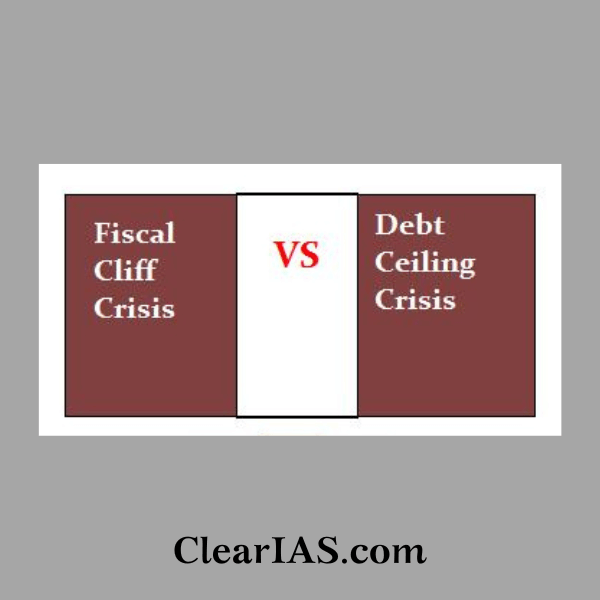
What is the debt ceiling? What are the solutions to the US debt ceiling crisis and US shutdown?
The last article from ClearIAS.com discussed about Sub-prime crisis and Fiscal Cliff. Things didn’t end there for the US economy. There were other problems to handle.
The next two major categories of economic issues were (1) the US debt ceiling crisis and the US Federal Government Shutdown and (2) Quantitative Easing and Federal Tapering.
Let’s discuss the US Debt Ceiling Crisis and the US Federal government shutdown in this post and discuss Quantitative Easing in another article. So, straight to the topic.
US Debt Ceiling Crisis
Do you remember that the Fiscal Cliff was rather a technical and policy issue rather than an economic issue? Do you remember the date December 31, 2012? On the same date, another related but different problem was creating trouble for the US government. This crisis too was related to bills. And the name of the crisis: US Debt Ceiling Crisis.
Back to Fiscal Cliff Crisis

The fiscal cliff crisis was partially solved with the passage of the American Taxpayer Relief Act of 2012 on Jan 1, 2013. This meant that there was a compromise that taxes should not be increased beyond a limit and there should not be excessive cuts on public expenditure. But this compromise had another problem – the debt ceiling – associated with it. That too, is a self-imposed, technical, and policy issue.
$1 trillion-plus annual budget gap of US!
Hope you are now clear about the fact that the economic condition of the US is not very good. $1 trillion-plus is the US annual budget gap (A figure which is around India’s GDP). Too much budget deficit is not good for any economy. The risk of reduction of credit rating always exists. Also, there are more chances of populism. So Budget Control Act of 2011 imposed restrictions on the debt limit of the US government. And that value was 16.399 trillion dollars.
Can you think of any way of reducing the $1 trillion-plus US annual budget deficit? The usual way out is either to increase taxes or reduce spending. But this contradicts the compromise on the Fiscal Cliff crisis. Besides, the two houses of the US Congress, are on two different pages, creating a deadlock. So what to do then?
What was needed to solve the Fiscal Cliff crisis was directly antagonistic to the solution of the US debt ceiling crisis. So it turned out that the solution to resolve the US debt ceiling crisis was not to reduce the debt, but rather increase or suspend the debt ceiling limit itself!
[Source: My own quote: For your understanding!]
Also read: Debt Sustainability
What is Debt ceiling? Who sets this figure?
- The limit is set by Congress. The United States will not be able to borrow any more money if it crosses the debt ceiling and would, in theory, be forced to slash spending to make ends meet.
- The debt limit does not control or limit the ability of the federal government to run deficits or incur obligations. Rather, it is a limit on the ability to pay obligations already incurred. It does not prohibit Congress from creating further obligations upon the United States. The ceiling was last set at $16.4 trillion in 2011.
- Possible, but desperate, remedies would include halting pay to the military, retirement health benefits, social security, and failing to pay government debts.
- The US will not default on its own debt immediately. The Treasury has various extraordinary measures in its armory, including halting the issuance of securities to state and local governments, which could buy about two months of leeway.
- After the passing in early January 2013 of the American Taxpayer Relief Act of 2012 to avert the projected fiscal cliff, political attention shifted to the debt ceiling.
- The debt ceiling had technically been reached on December 31, 2012, when the Treasury Department commenced “extraordinary measures” to enable the continued financing of the government.
Also read: Public Debt: Overview
United States Federal Government shut down
From October 1 through 16, 2013, the United States federal government entered a shutdown and curtailed most routine operations after Congress failed to enact legislation appropriating funds for fiscal year 2014, or a continuing resolution for the interim authorization of appropriations for fiscal year 2014. Regular government operations resumed on October 17 after an interim appropriations bill was signed into law. There was a conflict of interest on the Patient Protection and Affordable Care Act (commonly known as “Obamacare”) between Democrats and Republicans.
The 16-day-long shutdown of October 2013 was the third-longest government shutdown in U.S. history, after the 18-day shutdown in 1978 and the 21-day 1995–96 shutdown.
The US Government shutdown was rather a budget issue appropriation issue for the new fiscal year. It was connected with the US debt ceiling, but the shutdown issue was a short-term one (connected only with the spending for the next fiscal), but the debt ceiling was a long-term problem (connected with the long-term borrowing limit.)
[ Relate the Shutdown issue with a case like the Indian Budget got passed in Lok Sabha but not in Rajya Sabha; the Debt ceiling can be related to the provisions of the FRBM act which places restrictions on the Fiscal Deficit].
Also read: Budget Documents Made Simple
Solutions to US Debt Ceiling Crisis and US Shut down
Solution tried = Suspend the debt ceiling!
- The 2013 crisis began in January 2013 and ended on October 17, 2013, with the passing of the Continuing Appropriations Act, of 2014, though the debate continues.
- On October 16, the Senate passed the Continuing Appropriations Act, 2014, a continuing resolution, to fund the government until January 15, 2014, and suspend the debt ceiling until February 7, 2014, thus ending both the United States federal government shutdown of 2013 and the United States debt-ceiling crisis of 2013.
- On January 14, 2014, the House and the Senate Appropriations Committees agreed on a spending plan that would fund the federal government for two years.
- On January 16, 2014, Congress passed a $1.1 trillion appropriations bill that will keep the federal government funded until October 2014. (Short-term solution).
- Congress still needs to address the debt ceiling issue.
Read the third part of this article series in the link: Quantitative Easing and Federal Tapering Explained.






Leave a Reply